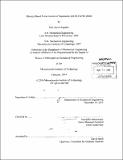| dc.contributor.advisor | Anuradha Annaswamy. | en_US |
| dc.contributor.author | Ragaller, Paul Aaron | en_US |
| dc.contributor.other | Massachusetts Institute of Technology. Department of Mechanical Engineering. | en_US |
| dc.date.accessioned | 2014-06-13T22:39:12Z | |
| dc.date.available | 2014-06-13T22:39:12Z | |
| dc.date.copyright | 2014 | en_US |
| dc.date.issued | 2014 | en_US |
| dc.identifier.uri | http://hdl.handle.net/1721.1/87980 | |
| dc.description | Thesis: Ph. D., Massachusetts Institute of Technology, Department of Mechanical Engineering, 2014. | en_US |
| dc.description | Cataloged from PDF version of thesis. | en_US |
| dc.description | Includes bibliographical references (pages 131-134). | en_US |
| dc.description.abstract | The effectiveness of ground plane water microjet control on the noise generated by a supersonic, ideally expanded, Mach 1.5, impinging jet was determined. Using a converging-diverging nozzle with a design Mach number of 1.5, the jet was operated at temperatures ranging from 60 to 1700°F. Six microjets were installed in the ground plane in a circular configuration at a radial spacing of 1.53 nozzle diameters, and an angle of 0 and 300 to tangential. Baseline and control temperature readings at the ground plane and acoustic readings at the sideline angles of 70, 80 and 900 were obtained with the microjets operating at pressures ranging from 200 to 900 psig. Additionally, in order to determine the fluid-mechanical mechanisms responsible for the control effect on the noise, high-speed images and video were obtained and analyzed. From measurements of the average and fluctuating ground plane temperature measurements, it was found that modifications to the High Temperature Supersonic Jet Facility at Florida State University allowed for measurements of impinging jet characteristics that were congruent with previous studies. Ground plane microjets were found to be effective in reducing feedback tones as a result of the impinging geometry of the jet. They were also effective at reducing the broadband spectral noise for lower temperatures. At temperatures higher than 600°F, however, an increase in the broadband noise was produced as a result of water microjets. At microjet injection pressures at and above 800 psig, additional noise suppression was achieved for the cold operating condition. From obtained high-speed images and video, it was found that the breakup of the microjet in the shear layer (of the shear variety), and the entrainment of fine mist into the inception of the shear layer was responsible for the reduction in strength and size of large-scale vortical structures. At higher pressures, additional noise suppression is produced as a combined result of the breaking of the feedback loop and the microjet's ability to penetrate to the high-speed side of the shear layer. | en_US |
| dc.description.statementofresponsibility | by Paul Aaron Ragaller. | en_US |
| dc.format.extent | 134, [1] pages | en_US |
| dc.language.iso | eng | en_US |
| dc.publisher | Massachusetts Institute of Technology | en_US |
| dc.relation.requires | DVD-ROM contains 4 videos in .avi format. | en_US |
| dc.rights | M.I.T. theses are protected by copyright. They may be viewed from this source for any purpose, but reproduction or distribution in any format is prohibited without written permission. See provided URL for inquiries about permission. | en_US |
| dc.rights.uri | http://dspace.mit.edu/handle/1721.1/7582 | en_US |
| dc.subject | Mechanical Engineering. | en_US |
| dc.title | Microjet based noise control of supersonic jets on carrier decks | en_US |
| dc.type | Thesis | en_US |
| dc.description.degree | Ph. D. | en_US |
| dc.contributor.department | Massachusetts Institute of Technology. Department of Mechanical Engineering | |
| dc.identifier.oclc | 880718455 | en_US |
